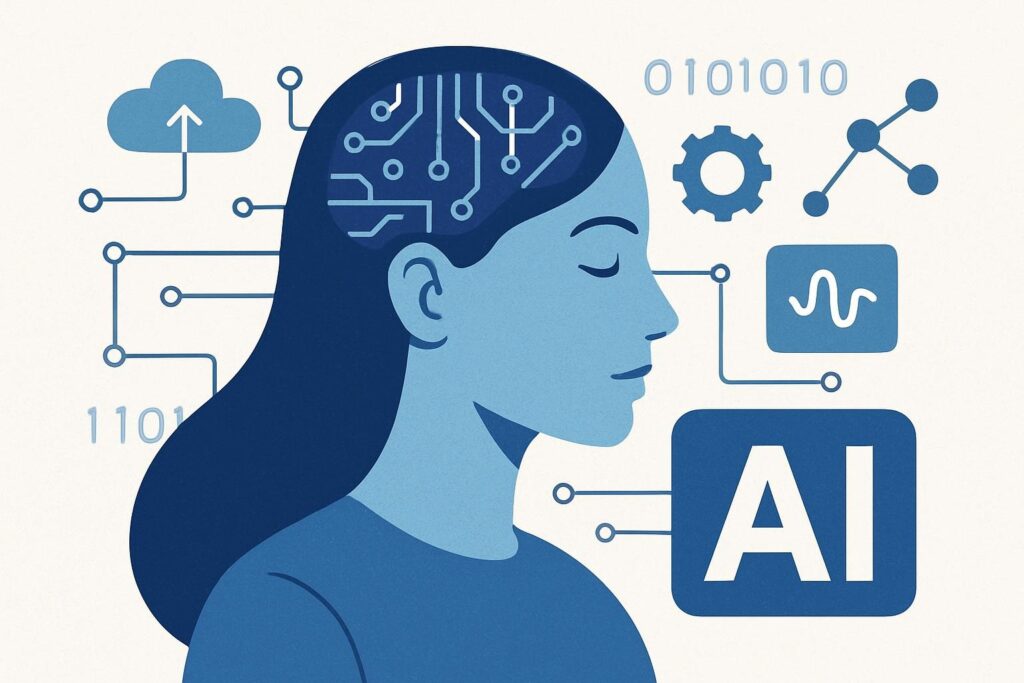
AI in recruitment is no longer a pilot or a promise—it’s the engine behind how modern teams source, assess, and hire at scale. From parsing millions of resumes in minutes to predicting candidate success and improving diversity pipelines, AI is redrawing the hiring playbook for employers in 2025. Yet the same tools that unlock speed and precision can also amplify bias, degrade candidate experience, or run afoul of fast-evolving regulations. This guide shows hiring leaders how to capture the upside of AI while staying human, fair, and compliant.
Why AI in Recruitment Is Accelerating Right Now
Three forces have converged to make AI in recruitment the default approach rather than an experiment:
- Data abundance: Millions of resumes, portfolios, coding challenges, and interview transcripts supply rich training data for talent models.
- Compute on demand: Cloud inference allows even mid-size firms to use powerful models without building in-house ML teams.
- Skills volatility: The half-life of skills keeps shrinking; employers must re-index job requirements and spot adjacent skills dynamically.
External evidence underscores the urgency. The World Economic Forum’s Future of Jobs 2023 report predicts major reshaping of roles and skills over five years, with AI among the top drivers of change. Read the WEF analysis.
Meanwhile, government and standards bodies have responded with guidance and frameworks. The U.S. NIST published the AI Risk Management Framework (AI RMF 1.0), a voluntary blueprint for trustworthy AI design and deployment. Explore NIST AI RMF. In the EU, the AI Act takes a risk-based approach and treats many HR systems as “high-risk,” triggering obligations for transparency, data governance, and human oversight. See the EU AI Act overview.
The Modern AI Hiring Stack
Best-in-class AI in recruitment isn’t one tool; it’s a layered stack that integrates with your ATS and collaboration systems:
- Programmatic Sourcing: Uses search, recommendations, and lookalike profiles to surface talent across job boards, social networks, and communities.
- Resume Parsing + Normalization: Converts unstructured resumes into structured skills and experience vectors for fair comparison.
- Screening & Ranking: Scores candidates against skill requirements and role outcomes, not proxies like school brand.
- Assessment: Work samples, coding challenges, and scenario sims scored by rubrics aligned to competencies.
- Interview Intelligence: Scheduling, question guidance, note-taking, and summarization for consistency.
- Offer & Onboarding: Compensation benchmarking, personalized pre-boarding paths, and time-to-productivity models.
To see how AI tools fit inside broader workflows, compare them with your existing collaboration stack. If you’re exploring workplace automation more generally, this primer helps: Workplace Automation Playbook (internal).
AI in Recruitment Sourcing: Talent Discovery at Scale
Traditional sourcing relies on boolean strings and manual outreach. With AI in recruitment, talent discovery becomes dynamic and inclusive:
- Skill graphs: AI maps adjacent and emerging skills so you don’t miss high-potential, non-linear candidates.
- Lookalike talent: Models find candidates who resemble your top performers—then you audit for fairness before use.
- Contextual matching: Rather than matching “keywords,” the model understands projects, outcomes, and seniority signals.
Employers can accelerate this discovery while keeping quality high by integrating sourcing with ATS feedback loops. Pair this with internal mobility to surface talent you already have. For an overview of AI tooling beyond HR, see AI at Work: Top Tools (internal).
AI Screening & Shortlisting Without Losing the Human Signal
AI-assisted screening compresses weeks into hours by parsing resumes, portfolio links, and public profiles. But high-volume automation raises two risks: false negatives (missing great candidates) and systemic bias. Keep the human signal strong:
- Use skills-first filters: Emphasize competencies, not pedigree. Align with structured rubrics—no “vibe-based” criteria.
- Require explanation: Use explainable ranking where feasible. When the system down-ranks, recruiters can review the rationale.
- Institute sampling checks: Manually sample rejected and borderline cases weekly to detect adverse impact early.
- Calibrate continuously: Feed outcomes (offers, ramp time, performance) back into the model with guardrails.
HBR has tracked how AI screening is reshaping candidate strategies and signals—useful context for interview debriefs and recruiter training. How to Get Hired When AI Does the Screening.
AI in Recruitment Assessments: Skills Over Proxies
Assessments are where AI in recruitment can most clearly reduce noise and increase fairness—if designed well. Replace “brain teasers” and gut-feel interviews with:
- Work sample sims: Realistic tasks scored by a rubric, optionally co-scored by AI for consistency.
- Structured prompts: Behavior-based questions mapped to competencies with rating anchors.
- Async video with coaching: AI suggests follow-ups and flags unsupported claims—but the hiring panel makes the decision.
To hold the line on fairness, connect your assessment approach to open frameworks and standards. The NIST AI Risk Management Framework offers a shared language for risk, transparency, and human oversight. SHRM also tracks trends and cautions for AI in HR tech: AI in Recruitment & Retention.
Interview Intelligence: AI in Recruitment That Enhances the Conversation
Interview intelligence platforms now handle scheduling, generate question banks, capture transcripts, and summarize candidate answers. Benefits include:
- Consistency: Every candidate faces the same core questions, cutting interviewer drift.
- Focus: With note-taking and summarization handled, interviewers can listen and probe more deeply.
- Enablement: New interviewers ramp faster with just-in-time guidance and example probes.
Use these tools to standardize—not to outsource—judgment. Build your interviewer capability with resources like Smart Interview Questions and Best Practices in the Workplace (internal).
From Offer to Onboarding: AI in Recruitment’s Last Mile
AI can reduce time-to-hire and enhance acceptance rates by predicting likely constraints (notice periods, counteroffers) and personalizing communication. At onboarding, models individualize learning paths and forecast time-to-productivity based on skills profiles.
- Compensation intelligence: Benchmark offers quickly; model cost-of-vacancy savings to unlock approvals.
- Personalized onboarding: Generate 30-60-90 plans with links to role-specific SOPs and mentors.
- First-year risk flags: Identify churn signals early to coordinate manager check-ins and peer support.
For managers, pair onboarding with team-level norms and communication hygiene. See Problem Solving in the Workplace and Meaningful Connections (internal).
Bias, Risk, and Compliance: Guardrails for AI in Recruitment
Ethical and compliant AI in recruitment requires clear accountability. Three pillars keep you safe and fair:
1) Data governance & explainability
Document data sources, consent basis, and retention. Track versioning for models and prompts. Where feasible, use explainable components so recruiters can challenge a ranking or score.
2) Human oversight & contestability
Humans must be able to override automated recommendations. Offer candidates an appeal channel for automated decisions. Consider jurisdictional obligations such as the EU AI Act’s requirements for high-risk systems. EU AI Act overview.
3) Legal frameworks & policy alignment
Align practices with EEOC guidance (U.S.) and similar national regulators elsewhere. The EEOC has published materials on AI decision-making tools, adverse impact analysis, and ADA implications. EEOC AI publications.
For a standards-based approach, adopt NIST’s AI RMF and, for generative systems, the NIST Generative AI profile. NIST GenAI profile.
Implementation Playbook: Rolling Out AI in Recruitment Responsibly
Phase 1: Discover
- Map your funnel: where are the real bottlenecks—sourcing, screening, scheduling, or assessment?
- Prioritize one high-impact, low-risk use case (e.g., scheduling automation or resume normalization).
- Define fairness goals (reduce variance, increase representation in slates) before you pick a tool.
Phase 2: Pilot
- Run A/B or pre/post comparisons across roles and locations, with sample size targets.
- Instrument data collection for outcome metrics and adverse impact monitoring.
- Train recruiters and hiring managers; use shadow mode before full automation.
Phase 3: Govern
- Create an AI Use Policy covering permissible use, human oversight, vendor due diligence, and candidate communications.
- Stand up an HR-Legal-Security review board and an issue escalation path.
- Schedule refresh cycles: quarterly for prompts and policies; semiannual for bias audits.
Phase 4: Scale
- Integrate with ATS/HRIS; centralize logs to support audits.
- Expand to adjacent use cases (internal mobility, upskilling pathways).
- Standardize interview kits with AI-assisted question banks and evaluation rubrics.
Measuring ROI: Metrics That Matter for AI in Recruitment
Choose lagging and leading indicators. Track both speed and quality, plus fairness and candidate experience:
- Speed: time-to-source, time-to-screen, scheduling latency, time-to-offer, time-to-start.
- Quality: first-year retention, performance at 6/12 months, ramp time, hiring manager satisfaction.
- Fairness: pass-through rates by stage for monitored groups; adverse impact ratios; calibration drift.
- Experience: candidate response rates, NPS, drop-off reasons, application friction.
- Cost: cost-per-hire, agency reliance, tool utilization, cost-of-vacancy avoided.
Round out your KPI set with broader workforce signals. For example, your Job Market Insights (internal category) can shape talent strategy and req prioritization.
What’s Next: The Near Future of AI in Recruitment
Skills ontologies will become living systems
Static job descriptions are giving way to living skills maps that update as your strategy shifts. LLM-powered copilots will draft job ads, interview plans, and onboarding paths from those maps.
Agentic workflows will stitch the funnel together
Expect agents to handle multi-step workflows—screening, scheduling, reminders, debrief summaries—under recruiter supervision. The art moves from “using a tool” to “designing the workflow.”
Compliance will differentiate mature employers
Employers who can demonstrate explainability, bias monitoring, and humane processes will win trust with both candidates and regulators. Keep an eye on new guidance from the EEOC, NIST, and the EU’s AI Office as rules mature. See EEOC guidance collections: EEOC Publications.
Putting AI in Recruitment to Work This Quarter
To move from theory to practice, pick one bottleneck, one team, and one AI tool. Run a four-week pilot, measure outcomes, and publish your results internally. Then scale with guardrails.
Complement your stack with practical efficiency boosters on the hiring team’s desktops—Time-Saving Chrome Extensions—and foundational hygiene like Workplace Cybersecurity Tips to protect candidate data.
FAQs: AI in Recruitment for Employers
Is AI in recruitment legal?
Generally yes, but requirements vary by jurisdiction. In the EU, the AI Act places obligations on HR-related systems classified as high-risk. In the U.S., the EEOC has issued materials covering AI decision-making tools, adverse impact, and disability considerations. Always pair AI with human oversight, document your rationale, and offer candidate recourse. See EEOC publications and EU AI Act.
How do we prevent bias when using AI in recruitment?
Adopt a skills-first approach, use diverse training data, run adverse impact tests each stage, maintain human review, and implement an AI governance program aligned to the NIST AI RMF. Communicate clearly to candidates where automation is used and how humans can intervene.
What metrics prove ROI?
Track time-to-hire, candidate quality (6/12-month performance), first-year retention, fairness metrics, and hiring manager satisfaction. Also monitor candidate NPS and application completion rates to ensure experience improves alongside efficiency.
Where should we start?
Begin with low-risk, high-friction tasks such as interview scheduling, resume normalization, or structured interview kits. Pilot with one business unit, publish results, then expand. Use our four-phase playbook to guide rollout.
Does AI replace recruiters?
No. AI augments recruiters by handling repetitive tasks so they can do higher-value work: stakeholder alignment, candidate storytelling, and assessment calibration. Recruiters become workflow designers and talent advisors.
How do we communicate AI use to candidates?
Use a plain-language disclosure: where AI is used, why, how to request human review, and how long data is retained. Provide a contact method for questions. This transparency builds trust and improves conversions.
What should our AI vendor due diligence include?
Ask for model cards or system documentation, bias audit results, explainability features, data retention policies, and breach response SLAs. Confirm your rights to export logs and outcomes for your own audits.
Further Reading & Sources
- World Economic Forum – Future of Jobs 2023
- NIST – AI Risk Management Framework (AI RMF 1.0)
- EU – AI Act Overview
- EEOC – AI-related publications and guidance
- Harvard Business Review – How to Get Hired When AI Does the Screening
- SHRM – AI in Recruitment & Retention



